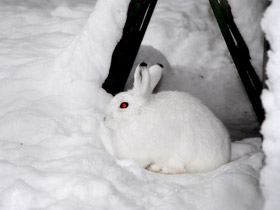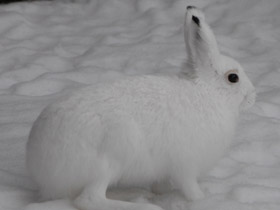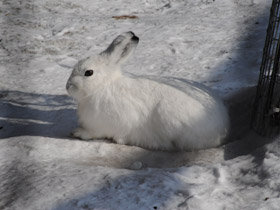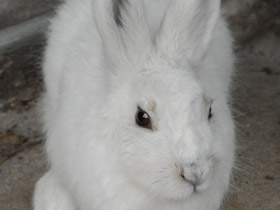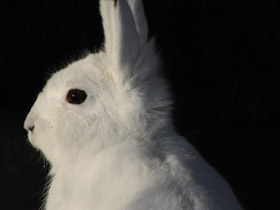The mountain hare (Lepus timidus), blue hare, tundra hare, variable hare, white hare, snow hare, alpine hare, and Irish hare
The mountain hare (Lepus timidus), also known as blue hare, tundra hare, variable hare, white hare, snow hare, alpine hare, and Irish hare, is a Palearctic hare that is largely adapted to polar and mountainous habitats.
Habitat, lifestyle and habits
Lepus timidus is a rather large animal - its body length is about 60 cm and its weight is from 1.6 to 4.5 kg. It inhabits tundra, forest and partly forest-steppe zones of Northern Europe, Russia, Siberia, Kazakhstan, Far East, Mongolia; it is also acclimatised in South America (Chile and Argentina). The ears of Lepus timidus are long, but still shorter than those of the russak; the tail is white, short and rounded, and the feet are broad (so as not to fall through the snow). In winter this hare is pure white except for the black tips of the ears, but in summer it is greyish or reddish.
Evolution
The mountain hare arose during the Late Pleistocene; there is evidence that its range expanded during glaciations into southern Europe, with populations of Iberian hare (Lepus granatensis), European hare (Lepus europaeus) and broom hare (L. castroviejoi) in northern Iberia harboring mitochondrial haplotypes from the mountain hare. During the Late Pleistocene to Early Holocene, populations of mountain hare in Russia grew at least 10% larger than any living population today. This population has been classified as a distinct species Lepus tanaiticus, but is now generally considered a prehistoric morphotype of the living mountain hare.
It is almost ubiquitous in the valleys of large rivers, where it not only finds good feeding conditions but also escapes parasites by "bathing" in riverine sand. In the tundra zone it gravitates to shrubby tundras; it is common near the sea coast. In the forest zone, it is almost never found in continuous forests (especially taiga forests) with high stand closure; the most attractive for it are forests sparse with meadows, river valleys, as well as with areas of old, overgrown burned areas and clearings. Central regions of Russia, where coniferous forest areas are usually adjacent to deciduous and agricultural lands, are very favourable for the squirrel. It avoids extensive open bogs. In Eastern Siberia it is common both in river valleys with willow thickets and in deciduous forests with well-developed undergrowth. In the forest-steppe of Western Siberia and Kazakhstan it is common in birch thickets, reed thickets and tall dense grass. In mountains (Alps, Altai, Sayans) it is found from foothills to mountain tundra and mountains. It is found everywhere in the vicinity of settlements.
Normally, Lepus timidus is solitary and territorial, occupying individual plots of 3-30 ha. In most of its range it is a sedentary animal, and its movements are limited to seasonal change of feeding grounds. In autumn and winter, seasonal relocations to forests are typical; in spring - to open areas where the first grass appears. Precipitation may be the reason for their movements - in rainy years hares leave lowlands and move to uplands. In the mountains they make seasonal vertical movements.
Lepus timidus is a herbivorous animal with clearly defined seasonality of feeding. In spring and summer it feeds on green parts of plants; in different parts of its range it prefers clover, dandelion, mouse pea, yarrow, goldenseal, bogweed, sedges and cereals. Readily feeds on oats and clover in fields. In the north-west of its range it eats bilberry shoots and fruits in large quantities. Occasionally eats horsetails and mushrooms, particularly deer truffle, which it digs out of the ground.
Human impact
In the European Alps, the mountain hare lives at elevations from 700 to 3,800 metres (2,300 to 12,500 ft), depending on biographic region and season. The development of alpine winter tourism has increased rapidly since the last few decades of the 20th century, resulting in expansion of ski resorts, growing visitor numbers, and a huge increase in all forms of snow sport activities. A 2013 study looking at stress events and the response of mountain hares to disturbance concluded that those hares living in areas of high winter recreational activities showed changes in physiology and behaviour that demanded additional energy input at a time when access to food resources is restricted by snow. It recommended ensuring that forests inhabited by mountain hares were kept free of tourist development, and that new skiing areas should be avoided in mountain hare habitat, and that existing sites should not be expanded.
In August 2016, the Scottish animal welfare charity OneKind launched a campaign on behalf of the mountain hare, as a way of raising awareness of mountain hare culls taking place across the country and in garnering public support for the issue. Mountain hares are routinely shot in the Scottish Highlands both as part of paid hunting "tours" and by gamekeepers managing red grouse populations (who believe that mountain hares can be vectors of diseases that affect the birds). Much of this activity is secretive, but investigations have revealed that tens of thousands of hares are being culled every year. The campaign, which urges people to proclaim, "We Care For The Mountain Hare", will culminate with the charity urging the Scottish government to legislate against commercial hunting and culling of the iconic Scottish species. The campaign has revealed widespread public support for a ban on hare hunting in Scotland. On May 17, 2020, MSPs voted to ban the unlicensed culling of mountain hares and grant them protected species status within Scotland after a petition started by Green MSP Alison Johnstone gathered over 22,000 signatures.
In 2021, the People's Trust for Endangered Species funded a survey of mountain hare populations in the UK's Peak District after concerns about the viability of the isolated population, believed to be as low as 2,500. The trust believes climate change is a threat to long-term survival of the Peak District population, which was introduced to the area in the 1870s.

















